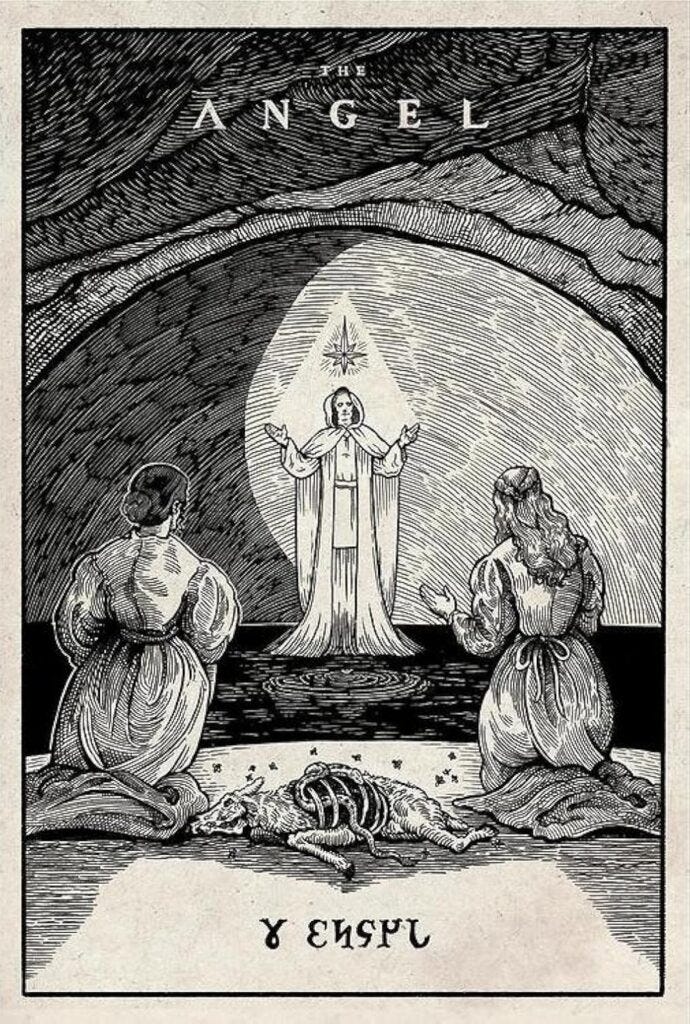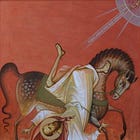Open Thou Mine Eyes
Think of a long imaginary line. A number line. All the numbers (real numbers) are on it. So 1 is there, as are 2, 3, 4, 5, 6 and even -1, -2, -3—all arranged in order from left to right. It goes on forever in both directions. All those numbers are sitting there, nice and evenly spaced, predictable. Also all of the rational numbers are there—the fractions: 2/3 , 7/8, 35/11 and so on. All ordered and fairly understandable.
At some point in your math education, a completely new number shows up. It’s called pi (π). Pi is like no other number that you’ve dealt with so far. It’s not something that you can count on your fingers or even express as a fraction. Pi is a new kind of creature. It belongs to a new class of numbers called “irrational numbers.” You probably first learn about it because it’s involved in calculating the area of a circle. Pi shows up whenever you talk about circles. Otherwise, it sort of stays in its corner. You know pi fits on the number line, somewhere right after the number 3, but it doesn’t mingle so well with the other numbers. It seems very different.
Pretty soon, another one shows up. The number e is another irrational number. It’s pretty important too, but not so obviously important at first. The number e is concerned with how things grow or change. And it is the most important number in calculus. If we put it on a number line, e sits between 2 and 3: 2.718—another infinite decimal number with no repeating pattern. So π and e are the first big irrational numbers you’re asked to keep track of. It turns out there are other irrational numbers you’ve been dealing with along the way, too: √2, √3, which made appearances in trigonometry. But still, the regular numbers keep you plenty busy. So our number line has all the counting numbers and the fractions (or “rational” numbers) and maybe a few odd “irrational numbers.”
You keep taking math classes, and one day in a math theory class, your professor says, “If you shoot an arrow at the real number line, you will always hit an irrational number.” If you shoot an arrow at the real number line, you will always hit an irrational number? This makes no sense at first. Couldn’t you possibly hit the rational number 35/11? No, the professor says. You will always hit an irrational number. Hmmm. The professor explains: the number line has these two groups of numbers: rational numbers (2, 5, 73) and irrational numbers (π, e, √2). Though there are an infinite number of each type of these numbers, the rationals and the irrationals, the infinite number of irrational numbers is a different type of infinity. The number line is simply saturated with irrational numbers. It is dripping with them. While you may not have noticed or perceived them, they are there—so thickly that, if you were to weigh the irrational numbers, they would equal the full weight of the number line. If you were to weigh the rational numbers, on the other hand, the ones you grew up so familiar with, their weight would be 0. Compared to the irrational numbers, the rational numbers contribute nothing. The irrational numbers completely dominate.
This is a bit of a shock. Your perception of real numbers is completely swallowed up in this new reality. So many things were there all along that you had never perceived. The things that you had perceived are there as well, but now you see that they are merely scaffolding for the vastness of the irrational numbers.
It’s hard not to see spiritual experiences the same way. Our daily experience is full of things we can see, taste, and touch. These tactile things are our experience and our attention is so dominated by the temporal. But throughout life, we begin to collect other experiences—times when we feel Heavenly Father communicating with us. These are dotted throughout our regular, physical life. These are spiritual experiences not seen with our eyes or felt with our hands. And they seem to be, at first, very singular events. By the time you’re an adult, you may remember only a handful of them.
I remember a morning of family scripture study when I was a teenager, reading the story of the raising of Lazarus and feeling the Spirit invite me to look closely at the unfolding and then resolution of this story—that there were details in it that could apply to my life. Another time, one Arizona summer, I sat in a grove of trees at a stake girls’ camp testimony meeting and felt God’s love. And reading the Book of Mormon on my own for the first time, as a young high school freshman, I learned enduring lessons in divine communication.
This handful of definite, conclusive messages of truth and love that I felt from God were touchstones in my early spiritual life. Somewhat spaced out in time and frequency, but nonetheless very real.
Time and experience have seemed to widen my ability to see. I’ve better learned the skill of reflection, which is like a pair of eyeglasses that God has patiently been waiting for me to put on. When I take the time to look, I perceive spiritual experiences and divine communications more regularly and acutely.
For example, one day, in a class I teach, a student nervously hands me a note right before the beginning of class: “Family emergency. Very traumatic. Please don’t call on me today.” Immediately, the Spirit whispers, Notice the courage. The bravery for him to even be here today.
Another time, I wake in the middle of the night while camping. Fumbling my way out of the tent, intending to read around the fire ring, the Spirit says, Look up, and I see a sky that has been roller-brush-painted with stars. I feel in my core the majesty of it all. After a few hours of sleep, waking again, I go to the same fire ring to sit, pre-dawn. Though the sun hasn’t come up yet, I see a production of warm colors on the horizon—so generous, perfect and beautiful: Enjoy this night and this morning that were created for you.
I see the man who plays his guitar, masterfully, not in concert halls or hip local venues, but in a hospital NICU. He travels from pod to pod, his audience composed of caregivers and babies in a fight for survival, his calm music helping everyone’s heart rate. And the Spirit helps me notice that he’s not even related to anyone at the hospital. He’s not even paid. Do I know not to take for granted this kindness?
One day I hear the second movement of Beethoven’s Piano Sonata No. 27 and conveyed to my mind and heart is an intimation of a better world.
A late-summer afternoon, at lunch at a Culver’s, I sit with an eighty-seven-year-old woman who, at that moment, is gifting a nineteen-year-old young man $25 to wish him well as he begins his first year at college. She gives him sweet, tender advice. Strangers to each other a few years before, she has loved him wholly and without guile in the years he has ministered to her as part of a church assignment. Where does that love come from? The Spirit insists that I consider.
When the exquisite and prolonged pain of loss arrives in my life, I understand what a “broken heart” means. This, too, is spiritual communication. I have to think about how this will be carried.
In the hallway at church, a sweet, newly minted twelve-year-old describes to me how it feels to be called as her Young Women class president. Before the calling came, she had already quietly helped her peers feel included, feel loved. Her sincerity and seriousness rival those of all of the seasoned leaders who are bustling around that same church building, who are also serious and sincere. If you look closely, the Spirit tells me, she can teach you new things to understand about charity.
“Open thou mine eyes, that I may see,” the psalmist wrote.
I’m sure that I am missing divine communication left and right. I treasure the spiritual communication I receive as I pray and as I study scripture and as I participate in ordinances. And as I grow, and as God allows, I feel more and more the messages—the spiritual lessons—that he is sending in the ordinary in-between times as well. At some point in the future, will we each look back with the lenses of our eyes completely opened to the spiritual experiences that we didn’t perceive but were happening all along? Perhaps similar to how the irrational numbers swallow up the rational numbers, will the full weight of the spiritual totally swallow up the temporal?
President Ezra Taft Benson once said, “Nothing is going to startle us more when we pass through the veil to the other side than to realize how well we know our Father and how familiar his face is to us.”
Is it possible that we will also be surprised by just how thickly laid our lives were with spiritual connection? Surprised by the fact that the tactile features of life were just the barest of scaffolding, and the spiritual aspects comprised the grander weight all along?
Laura Housley is an adjunct mathematics professor at a local community college and mother of five. She met her husband in an abstract algebra class. Primary chorister is her favorite calling.
Art by Wassily Kandinsky (1866–1944).
JOIN WAYFARE JULY 12TH FOR A FILM SCREENING AND CONVERSATION: THE ANGEL
As part of the 2025 Wayfare Festival, join us on July 12th at 7pm for a screening of The Angel, a film by Barrett Burgin. Afterwards, enjoy a discussion of the film and LDS filmmaking in general with Joshua Sabey and Sarah Perkins, accompanied with gourmet popcorn.









Thank you for this. It is lovely and evocative. I will seek better to see better.